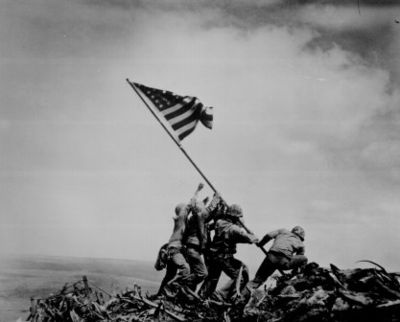Clint Eastwood is probably one of America’s most mature contemporary directors, and I’m not talking about his age. Aside from Robert Redford, no other director is trustworthy enough to ensure that what goes onscreen will not be the stuff of a little boy’s fancy.
In “Flags of Our Fathers,” Eastwood delivers what is arguably his most ambitious and, sadly, most unfocused movie to date. It’s a shame that with so much maturity and talent, Eastwood has no idea what story he wants to tell. There’s a good one in there somewhere, if only he could find it and stick with it.
Instead, he haphazardly bounces between ideas and incidents, with no real cohesion between them. It doesn’t help that the film has five narrators, and three of them have no direct connection to the story at hand.

The first part of the movie cuts between the Battle of Iwo Jima (with the subsequent flag-raising) and the impact the photo of that event is having on the general public, including surviving soldiers John “Doc” Bradley, Rene Gagnon and Ira Hayes (Ryan Phillippe, Jesse Bradford and Adam Beach, respectively).
Hayes gets the most screen time and spends the majority of it agonizing over the loss of his fallen comrades. But because very little time is devoted to the fallen soldiers, the audience never gets to know them, and viewers know even less about why their deaths are so haunting to Hayes.
In fact, most of the time spent with Hayes and his fellow soldiers really only illustrates what an outsider he is.
It’s sometimes difficult to even discern who is who because the movie tosses around characters as if they were all disposable, hardly bothering to place names with faces.
Thematically, Eastwood tries to make a statement about how the media can control the outcome of a war by manipulating the emotions of the public. Simultaneously, he tries to tell a story about how heroes never feel like heroes and how a public that needs to believe in mythology creates them. The majority of the audience knows the soldiers don’t feel like heroes because they are reminded of it virtually every time the actors are on screen.
As this is a war film, there are plenty of battle scenes. But in the post-“Saving Private Ryan” era, it makes little sense for Eastwood to spend so much screen time (and costly computer effects) on the battles. “Ryan” showed us with vivid clarity what war does to the human mind and body, and “Flags” does nothing to emphasize the point.
The acting is not particularly noteworthy, either – a rare oddity for an Eastwood movie. Beach, in particular, is given little to do but look agonized and isolated. The only strong performances come from Barry Pepper and Neal McDonough as two of the fallen heroes. But their screen time is entirely too brief, and their characters are never realized.
The most intriguing feature about “Flags of Our Fathers” has always been its companion piece, “Letters from Iwo Jima,” set for release in February. It tells the story of Iwo Jima from the Japanese perspective. Sadly, the disordered storytelling in this current film has caused my interest in the upcoming movie to flag as well.
Originally published in The Daily Aztec.

You must be logged in to post a comment.